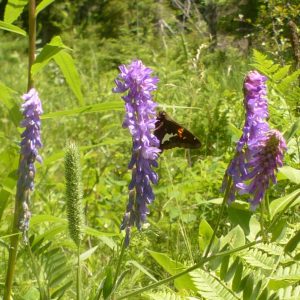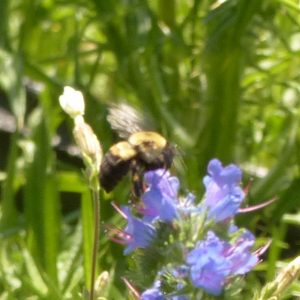by Sandy Garland
I read about a country-wide Canada Day bioblitz and decided to forego fireworks for a day in the country trying to photograph 152 (Canada’s age) species of everything. Unfortunately, I managed only 143, but here are the pollinators among them.
I counted as a pollinator anything that was sitting on a flower. So, Silver-spotted Skipper, because it was perched on vetch, but not Hobomok Skipper because it was on a leaf. I uploaded all to the Canada 152 project site in iNaturalist and, as a result, received help with identification.
It was fun learning a bit about these pollinators and seeing such diverse species. I hope I will recognize them next time I see them.
 Small mason wasp. This insect is after nectar, like the butterflies below, but accidentally transfers pollen from one flower to another, making it a pollinator too. |
 Sweat Bee (Agapostemon) on a Purple-flowering Raspberry. |
 Flower longhorn beetle (Strangalepta abbreviata) on an Oxeye Daisy. |
 Northern Cloudywing (Thorybes pylades) on vetch. The larval host for this butterfly is tick trefoil. |
 Silver-spotted Skipper (Epargyreus clarus) on vetch. These large skippers are easy to identify with that bright white spot on its front wing, visible even when folded. They also nectar on vervain later in the season. |
 Lasioglossum on Purple-flowering Raspberry. This is a small sweat bee in the family Halictidae. |
 Bumble bee on Viper’s Bugloss |
 Bumble bee found dead on the road. One way to distinguish bees from flies is by wing number (4 and 2, respectively), but it’s very difficult to count wings on a flying insect (see blurry bumble bee in previous photo). The only good side to finding a dead one is the ability to study these features closely. |
|







